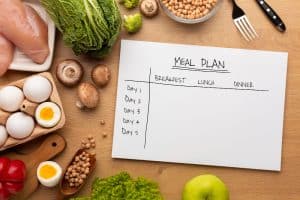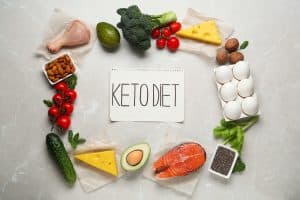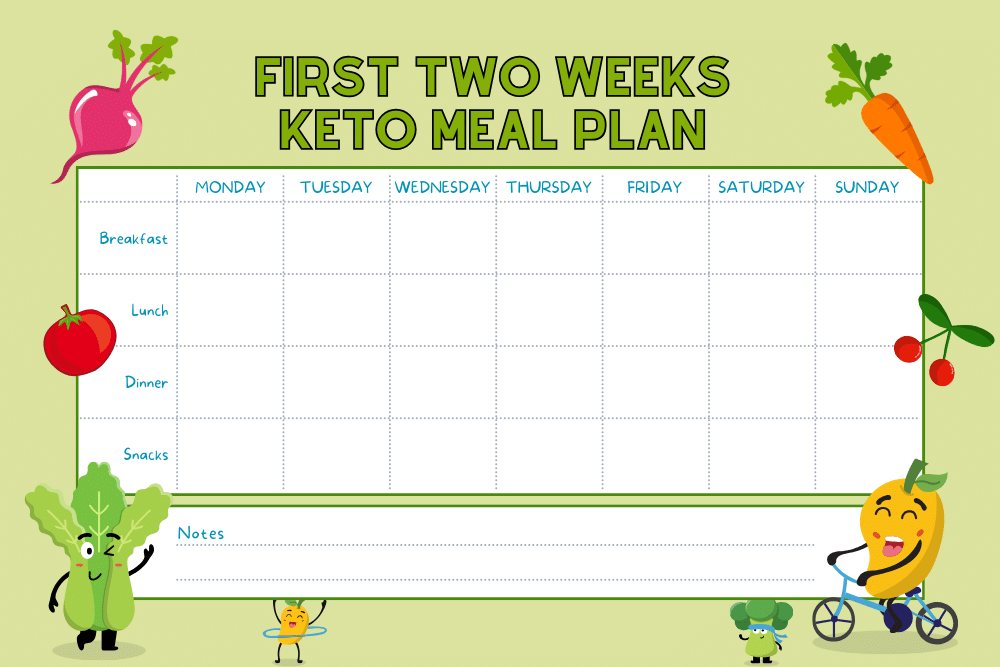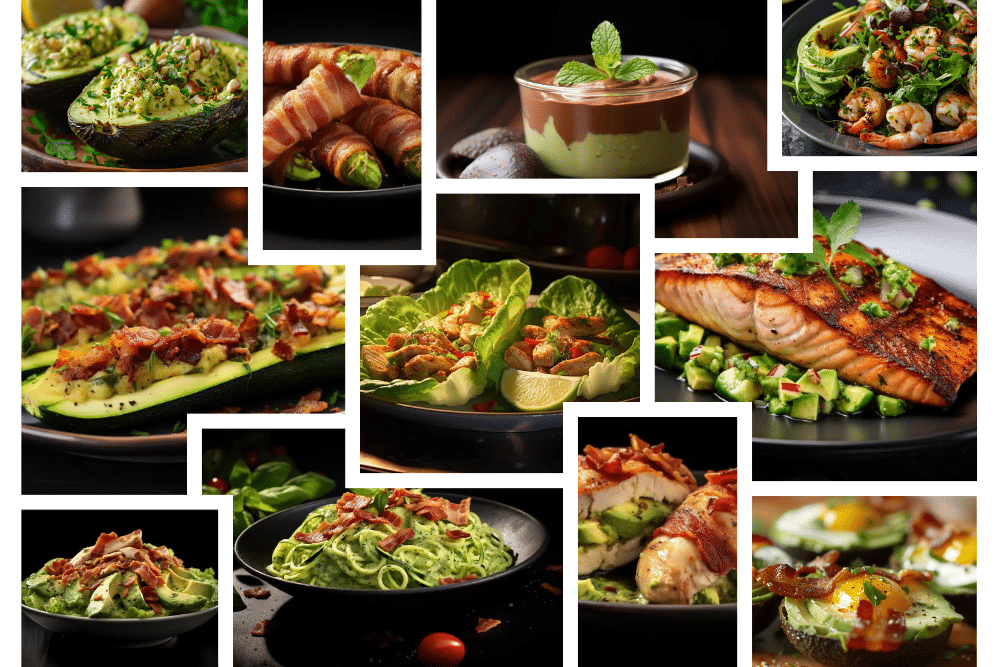Embarking on the ketogenic diet can be a transformative journey toward better health, weight loss, and increased energy. This low-carb, high-fat diet shifts your body into a state of ketosis, where fat becomes the primary source of energy, leading to numerous health benefits. However, the initial phase is crucial, and that’s where the first two weeks keto meal plan come into play.
These first two weeks are not just about adapting to a new way of eating; they’re about laying a solid foundation for your keto journey. A well-structured meal plan during this period can help ease the transition, minimise symptoms of the ‘keto flu,’ and set you up for long-term success. Let’s dive into how you can kickstart your journey confidently and clearly, ensuring your first steps on the keto path lead you toward your health and wellness goals.
Understanding Keto Basics

To successfully embark on your first two weeks keto meal plan, it’s crucial to grasp the keto basics. The cornerstone of the ketogenic diet is inducing a metabolic state known as ketosis, where your body burns fat for fuel instead of carbohydrates. This shift not only aids in weight loss but also enhances mental clarity and energy levels, making it a sought-after lifestyle change for many.
Achieving ketosis hinges on adhering to specific macronutrient ratios: a high intake of fats, a moderate intake of proteins, and a minimal intake of carbohydrates. Your daily calorie consumption should typically consist of 70-80% fats, 20-25% proteins, and 5-10% carbohydrates. This balance is pivotal during the first two weeks of the keto meal plan as your body begins transitioning from glucose reliance towards efficiently using fats for energy.
Understanding these macronutrient ratios and the process of ketosis is fundamental to navigating your initial keto journey. By meticulously planning your meals to fit these criteria, you’re laying the groundwork for a successful transition into ketosis. For a deeper dive into ketosis and how to optimise your diet for this metabolic state, click here to learn more. This initial phase is your stepping stone to reaping the full benefits of the ketogenic lifestyle, setting the stage for enduring health improvements.
Foods to Embrace
As you embark on your first two weeks keto meal plan, understanding which foods to embrace is critical to setting yourself up for success. The ketogenic diet emphasises high-fat, low-carb foods to help your body transition into ketosis efficiently. Here’s a breakdown of keto-friendly food groups to incorporate into your diet:
- Meats and Fatty Fish: Opt for grass-fed meats, fatty fish like salmon and mackerel, and other protein sources rich in omega-3 fatty acids. These not only support ketosis but also contribute to overall health and wellness.
- Eggs and High-Fat Dairy: Eggs are a staple in the keto diet due to their nutritional profile and versatility. High-fat dairies, such as cheese, butter, and heavy cream, can also be included, providing both flavour and fat content essential for ketosis.
- Healthy Fats: Incorporating avocados, olive oil, and coconut oil into your meals adds healthy fats to promote energy production and satiety. These fats are crucial during the first two weeks keto meal plan for sustaining energy levels and supporting cellular functions.
- Low-Carb Vegetables: Vegetables like leafy greens, broccoli, and cauliflower are low in carbs but high in fibre and nutrients. They are perfect for adding volume to your meals without exceeding your carb limit.
- Nuts and Seeds: For snacks or meal additions, nuts and seeds offer a great source of fats, proteins, and minimal carbs. Almonds, walnuts, flaxseeds, and chia seeds are excellent choices for keeping hunger at bay and providing energy.
Incorporating these food groups into your first two weeks keto meal plan not only aids in the transition to ketosis but also ensures you’re nourishing your body with quality ingredients. Balancing these foods within your daily intake will help you achieve the optimal macronutrient ratios needed for ketosis, setting a solid foundation for your keto journey.
Foods to Avoid
![]()
In your journey through the first two weeks keto meal plan, being mindful of the foods to avoid is as crucial as knowing which foods to embrace. The goal of maintaining ketosis requires minimising or eliminating certain types of foods that can disrupt this metabolic state. Here’s a closer look at the foods you should steer clear of:
- Sugary Foods and Drinks: Sugar is a primary culprit in knocking you out of ketosis. This includes candy, sodas, desserts, and seemingly healthy options like fruit juices. These foods spike insulin levels and provide a quick source of glucose, which is counterproductive on keto.
- Grains: Bread, pasta, rice, and cereals are high in carbohydrates and can quickly exceed your daily carb allowance. These staple foods in many diets must be set aside as you follow your first two weeks keto meal plan.
- High-Carb Fruits: While fruits are nutritious, many are high in sugars and carbs. For example, bananas, apples, and grapes can hinder your progress into ketosis. Opt for lower-carb fruits like berries in moderation.
- Starchy Vegetables: Vegetables like potatoes, sweet potatoes, and corn offer health benefits but are rich in starches. On keto, focusing on non-starchy, low-carb vegetables is better to keep carb intake in check.
- High-Carb Dairy Products: Some dairy products, particularly low-fat ones, can contain added sugars or naturally higher carb content. For instance, milk and low-fat yogurts may need to fit better within the first two weeks keto meal plan due to their higher carb content.
By carefully avoiding these foods, you can ensure that your transition into and maintenance of ketosis is smooth and effective. Adhering to the dietary guidelines outlined in your first two weeks keto meal plan is vital for reaping the full benefits of the ketogenic lifestyle, from weight loss to enhanced energy and beyond.
First Two Weeks Keto Meal Plan for Success

Crafting a successful first two weeks keto meal plan is pivotal for easing into ketosis while ensuring your meals are both nutritious and enjoyable. Below is a sample meal plan for your first week, designed to offer variety and optimise your intake of essential nutrients. Alongside the meal plan, you’ll find tips for meal prep and strategies to help you stay on track.
Day 1
Breakfast: Keto Blueberry Muffins. Get the full recipe here.
Lunch: Keto Buffalo Chicken Lettuce Wraps. Dive into the recipe here.
Dinner: Creamy Mushroom and Spinach Stuffed Chicken. Find the recipe here.
Day 2
Breakfast: Bacon-Wrapped Avocado Fries. Get the full recipe here.
Lunch: Spinach and Feta Stuffed Chicken Thighs. Dive into the recipe here.
Dinner: Keto Eggplant Parmesan. Find the recipe here.
Day 3
Breakfast: Keto Chia Seed Pudding with Berries. Get the full recipe here.
Lunch: Keto Egg Salad Lettuce Wraps. Dive into the recipe here.
Dinner: Garlic Butter Herb Grilled Chicken. Find the recipe here.
Day 4
Breakfast: Low-Carb Sausage and Egg Breakfast Burrito. Get the full recipe here.
Lunch: Beef and Cabbage Casserole. Dive into the recipe here.
Dinner: Keto Pork Chops with Creamy Mushroom Sauce. Find the recipe here.
Day 5
Breakfast: Keto Ham and Cheese Breakfast Casserole. Get the full recipe here.
Lunch: Keto Spinach and Feta Stuffed Mushrooms. Dive into the recipe here.
Dinner: Keto Chicken Cordon Bleu Casserole. Find the recipe here.
Day 6
Breakfast: Spinach and Bacon Egg Muffins. Get the full recipe here.
Lunch: Avocado and Bacon Chicken Salad. Dive into the recipe here.
Dinner: Creamy Roasted Red Pepper and Basil Soup. Find the recipe here.
Day 7
Breakfast: Keto Breakfast Tacos with Lettuce Wraps. Get the full recipe here.
Lunch: Keto Beef and Broccoli Bowls. Dive into the recipe here.
Dinner: Keto Chili with Ground Beef. Find the recipe here.
Day 8
Breakfast: Coconut Flour Pancakes with Berries. Get the full recipe here.
Lunch: Keto Creamed Spinach with Parmesan. Dive into the recipe here.
Dinner: Keto Baked Cod with Garlic and Butter. Find the recipe here.
Day 9
Breakfast: Keto Mushroom and Spinach Breakfast Skillet. Get the full recipe here.
Lunch: Mediterranean Chicken Skewers with Tzatziki Sauce. Dive into the recipe here.
Dinner: Keto Creamy Garlic Parmesan Brussels Sprouts. Find the recipe here.
Day 10
Breakfast: Low-Carb Zucchini Fritters. Get the full recipe here.
Lunch: Keto Chicken and Vegetable Stir-Fry. Dive into the recipe here.
Dinner: Keto Beef and Zucchini Skillet. Find the recipe here.
Day 11
Breakfast: Smoked Salmon and Avocado Breakfast Salad. Get the full recipe here.
Lunch: Creamy Tomato Basil Soup. Dive into the recipe here.
Dinner: Keto Creamy Cajun Shrimp. Find the recipe here.
Day 12
Breakfast: Keto Breakfast Sausage Patties. Get the full recipe here.
Lunch: Keto Grilled Salmon with Avocado Salsa. Dive into the recipe here.
Dinner: Keto Chicken and Spinach Alfredo. Find the recipe here.
Day 13
Breakfast: Keto Bacon and Egg Breakfast Bites. Get the full recipe here.
Lunch: Keto Cauliflower and Bacon Gratin. Dive into the recipe here.
Dinner: Sun-Dried Tomato and Feta Stuffed Chicken. Find the recipe here.
Day 14
Breakfast: Keto Breakfast Stuffed Bell Peppers. Get the full recipe here.
Lunch: Chicken and Avocado Lettuce Wraps. Dive into the recipe here.
Dinner: Keto Stuffed Portobello Mushrooms. Find the recipe here.
Additional Meal Planning Tips for Success
- Hydration: Keep water intake high to help transition and stay hydrated.
- Keto Snacks: Make keto snacks available to combat hunger between meals without derailing your progress. ➤ Click here to buy keto-friendly snacks from our carefully curated selection.
- Flexibility: Be prepared to adjust the meal plan based on how your body responds. If certain meals leave you feeling more satisfied or energised, consider incorporating them more frequently.
Tips for Meal Prep
- Batch Cook: Prepare large portions of proteins and veggies at the start of the week. Store them in the fridge for easy assembly of meals.
- Pre-portion Snacks: Portion snacks like nuts, cheese, and olives in advance to avoid overeating.
- Simplify Breakfast: Consider making a large batch of a simple breakfast option, like chia pudding, that you can enjoy throughout the week.
Staying on Track
- Plan Ahead: Spend time each week planning your meals to avoid the temptation of off-plan eating.
- Keep It Interesting: Experiment with new recipes to keep your meals exciting and prevent boredom.
- Listen to Your Body: Adjust portions and meal components based on your hunger and energy levels.
Managing Expectations and Symptoms

Implementing a structured first two weeks keto meal plan like this ensures you cover all nutritional bases, making your transition into ketosis as smooth as possible. Remember, variety is key to maintaining interest and ensuring you get a wide range of nutrients. With proper planning and preparation, you’re setting yourself up for success in your keto journey.
Managing your expectations and being prepared for potential symptoms are key to navigating through your first two weeks keto meal plan. The transition to a ketogenic lifestyle often brings about the keto flu, a term coined to describe the initial side effects some experience as their bodies adjust to using fat for fuel instead of carbohydrates. Symptoms of the keto flu can include fatigue, headaches, irritability, and difficulty sleeping, which typically manifest in the early stages of the diet.
Strategies for Mitigating Symptoms
- Hydration: One simplest yet most effective way to combat the keto flu is to stay well-hydrated. Increasing your water intake can help flush out toxins and reduce some of the keto flu symptoms.
- Electrolyte Supplementation: Since the ketogenic diet can alter mineral and electrolyte balance, supplementing with critical electrolytes—sodium, potassium, and magnesium—can be crucial. These supplements help replenish what is lost during the diuretic effect of entering ketosis and can alleviate cramps, headaches, and fatigue. ➤ Find the right electrolyte supplements for your keto journey here.
- Adjust Your Diet: Incorporating more bone broth, fatty fish, and leafy greens into your meals can boost electrolyte levels. Paying close attention to your intake of these nutrients can help you manage symptoms more effectively.
- Ease Into Exercise: If you’re feeling lazy or weak, consider reducing the intensity of your workouts during the first two weeks keto meal plan. Gentle exercises like walking or yoga can help you stay active without overexerting yourself.
Understanding and preparing for these initial side effects can make your transition to the ketogenic diet smoother. By staying hydrated, supplementing with electrolytes, and listening to your body, you can mitigate the symptoms of the keto flu and continue on your path to achieving the benefits of ketosis.
Remember, these symptoms are temporary, and with the right strategies in place, you’ll soon be able to enjoy the increased energy and improved well-being that come with a well-managed ketogenic lifestyle.
Supplementing Your Diet

In the first two weeks keto meal plan, supplementing your diet becomes a critical strategy for ensuring nutritional balance and supporting your body’s adjustment to ketosis. Beyond focusing on macronutrients, paying attention to electrolytes and fibre is essential for maintaining health and comfort during your keto journey.
- Electrolytes: The ketogenic diet can lead to a significant reduction in electrolytes, such as sodium, potassium, and magnesium, due to decreased carbohydrate intake and the diuretic effect of entering ketosis. Supplementing electrolytes is important to prevent symptoms like fatigue, headaches, and muscle cramps. Look for quality electrolyte supplements that provide a balanced blend of these minerals without added sugars or carbs. Adding a pinch of salt to your water or consuming broth can also help maintain sodium levels. ➤ Find the right electrolyte supplements for your keto journey here.
- Fibre: Since the keto diet restricts high-carb fruits, vegetables, and whole grains, you might find it challenging to meet your daily fibre needs, leading to digestive issues such as constipation. Incorporating a fibre supplement can aid digestion and help maintain gut health. Look for natural fibre supplements like psyllium husk, flaxseed, or chia seeds, which can be easily added to keto-friendly meals or smoothies without excess carbs.
Always opt for supplements with minimal additives and ensure they align with your keto goals. Integrating these supplements into your first two weeks keto meal plan can help smooth your transition into ketosis, support your body’s nutritional needs, and enhance your overall experience on the ketogenic diet. Remember, while supplements can provide valuable support, they should complement, not replace, a well-rounded keto diet rich in nutrient-dense foods.
Beyond the First Two Weeks

As you move beyond the first two weeks keto meal plan, you’ll find yourself more adapted to the ketogenic lifestyle, both metabolically and habitually. This phase is an opportune time to gradually expand your diet, introducing new keto-friendly foods that add variety and additional nutrients to your meals. However, it’s crucial to maintain the core principles of keto: high fat, moderate protein, and low carbohydrates.
Expanding Your Diet
Start by incorporating a wider variety of low-carb vegetables to diversify your nutrient intake. Vegetables like bell peppers, eggplants, and mushrooms can add colour, flavour, and essential vitamins to your dishes.
Experiment with different sources of healthy fats, such as MCT oil, other nuts, seeds, or avocado varieties. These can enhance your meals while keeping you in ketosis. Explore new protein options, like less common cuts of meat, offal, or wild-caught seafood, to keep your protein intake exciting and varied.
Listening to Your Body
Notice how new foods affect your energy levels, digestion, and well-being. Some foods, even keto-friendly, might need to be better with you. It’s important to recognise and respect your body’s signals. Monitor your ketosis state using ketone test strips or a blood ketone meter. This can help you understand how different foods and portion sizes impact your ketosis level.
➤ Get your ketosis monitoring tools here.
Making Adjustments
If you encounter any digestive issues, consider adjusting your fibre intake or supplementing with digestive enzymes to aid digestion. Should you find your weight loss plateauing, reassess your caloric intake and macronutrient ratios. Minor tweaks can often reignite progress. Continuously educate yourself on keto principles and nutritional science. The more you know, the better you’ll be able to make informed decisions about your diet.
Transitioning beyond the first two weeks keto meal plan is about maintaining ketosis and nurturing a sustainable, enjoyable, and healthful eating pattern. Listening to your body and being willing to make necessary adjustments are key to long-term success on the ketogenic diet. This approach ensures that keto becomes a temporary diet and a lasting lifestyle change.
Conclusion
Embarking on your first two weeks keto meal plan is crucial in your journey toward a healthier lifestyle. This initial phase is fundamental in setting the tone for your keto journey, helping your body adjust to burning fat for fuel, and establishing the habits that will carry you towards your health and wellness goals. Sticking to the plan during these initial weeks can challenge your resolve. Still, it’s also an opportunity to learn about your body, discover new foods, and begin reaping the benefits of ketosis.
Remember that every small step is a victory for those of you embarking on this journey. The transition to ketosis is a process, and like any significant change, it comes with its ups and downs. Your dedication in these first two weeks lays the groundwork for the transformative changes you’ll see in your health, energy, and overall well-being. Embrace the journey, be patient with yourself, and stay committed to your goals.





